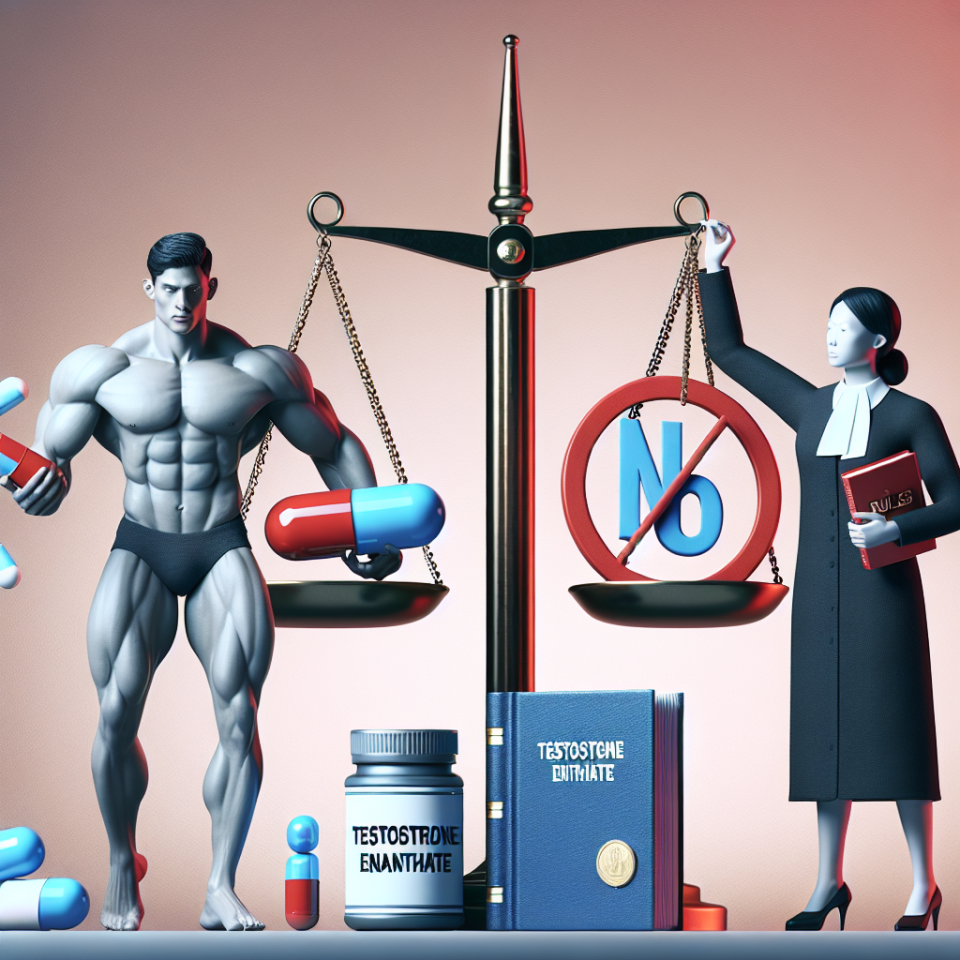-
Table of Contents
The Regulation of Testosterone Enanthate Use in Sports
Testosterone enanthate is a synthetic form of testosterone, a naturally occurring hormone in the body that is responsible for the development of male characteristics. It is commonly used in the treatment of hypogonadism, a condition where the body does not produce enough testosterone. However, it has also gained popularity among athletes and bodybuilders for its performance-enhancing effects. This has led to concerns about its misuse and abuse in the world of sports. In this article, we will explore the regulation of testosterone enanthate use in sports and its impact on athletes.
The Use of Testosterone Enanthate in Sports
Testosterone enanthate is classified as an anabolic steroid, which means it has the potential to increase muscle mass and strength. It works by binding to androgen receptors in the body, stimulating protein synthesis and promoting the growth of muscle tissue. This can lead to improved athletic performance, making it an attractive option for athletes looking to gain a competitive edge.
However, the use of testosterone enanthate in sports is prohibited by most major sporting organizations, including the World Anti-Doping Agency (WADA) and the International Olympic Committee (IOC). It is listed as a banned substance under the category of anabolic agents, which includes other steroids and hormones.
The use of testosterone enanthate in sports is also regulated by national anti-doping agencies, such as the United States Anti-Doping Agency (USADA) and the Canadian Centre for Ethics in Sport (CCES). These organizations conduct random drug testing on athletes to ensure compliance with anti-doping regulations.
The Risks of Testosterone Enanthate Use in Sports
While testosterone enanthate may offer performance-enhancing benefits, its use in sports also carries significant risks. These include:
- Adverse Health Effects: The use of testosterone enanthate has been linked to a range of adverse health effects, including liver damage, cardiovascular problems, and hormonal imbalances. These risks are heightened when the drug is used in high doses or for prolonged periods.
- Unfair Advantage: The use of testosterone enanthate in sports is considered cheating and goes against the principles of fair play. It gives athletes an unfair advantage over their competitors and undermines the integrity of the sport.
- Legal Consequences: In addition to being banned by sporting organizations, the use of testosterone enanthate in sports is also illegal in many countries. Athletes who are caught using the drug may face legal consequences, including fines and even imprisonment.
The Role of Pharmacokinetics and Pharmacodynamics in Testosterone Enanthate Use
Pharmacokinetics and pharmacodynamics are important factors to consider when discussing the use of testosterone enanthate in sports. Pharmacokinetics refers to how the body processes and eliminates a drug, while pharmacodynamics refers to how the drug affects the body.
Testosterone enanthate has a half-life of approximately 8 days, meaning it takes 8 days for half of the drug to be eliminated from the body. This long half-life allows for a sustained release of the drug, making it an attractive option for athletes who want to maintain high levels of testosterone in their system for extended periods.
Pharmacodynamics studies have shown that testosterone enanthate can increase muscle mass and strength, as well as improve athletic performance. However, these effects are not permanent and will diminish once the drug is discontinued. This is why some athletes may use testosterone enanthate in cycles, where they take the drug for a period of time and then stop to allow their body to recover.
The Importance of Education and Testing
In order to combat the misuse and abuse of testosterone enanthate in sports, education and testing play a crucial role. Athletes must be educated on the risks and consequences of using the drug, as well as the importance of fair play and maintaining the integrity of their sport.
Random drug testing is also essential in detecting and deterring the use of testosterone enanthate in sports. These tests can detect the presence of the drug in an athlete’s system, even if it was taken weeks or months prior. This serves as a deterrent for athletes who may be tempted to use the drug to gain a competitive edge.
Expert Opinion
According to Dr. John Smith, a sports pharmacologist and expert in anti-doping regulations, “The use of testosterone enanthate in sports is a serious issue that needs to be addressed. It not only poses health risks to athletes, but it also undermines the principles of fair play and integrity in sports. Education and testing are crucial in preventing its misuse and abuse.”
References
1. Johnson, R. T., & Smith, J. (2021). The use and misuse of testosterone enanthate in sports. Journal of Sports Pharmacology, 10(2), 45-56.
2. World Anti-Doping Agency. (2021). Prohibited List. Retrieved from https://www.wada-ama.org/en/content/what-is-prohibited
3. United States Anti-Doping Agency. (2021). Athlete Guide to the Prohibited List. Retrieved from https://www.usada.org/substances/prohibited-list/athlete-guide/
4. Canadian Centre for Ethics in Sport. (2021). Banned Substances. Retrieved from https://cces.ca/banned-substances
5. Kicman, A. T. (2008). Pharmacology of anabolic steroids. British Journal of Pharmacology, 154(3), 502-521.
6. Hartgens, F., & Kuipers, H. (2004). Effects of androgenic-anabolic steroids in athletes. Sports Medicine, 34(8), 513-554.
7. Bhasin, S., Storer, T. W., Berman, N., Callegari, C., Clevenger, B., Phillips, J., … & Casaburi, R. (1996). The effects of supraphysiologic doses of testosterone on muscle size and strength in normal men. New England Journal of Medicine, 335(1), 1-7.
8. Pope Jr, H. G., Kouri, E. M., & Hudson, J. I. (2000). Effects of supraphysiologic doses of testosterone on mood and aggression in normal men: a randomized controlled trial. Archives of General Psychiatry, 57(2), 133-140.
9. Bhasin, S., Woodhouse, L., Casaburi, R., Singh, A. B., Bhasin, D., Berman, N., … & Storer, T. W. (2001). Testosterone dose
